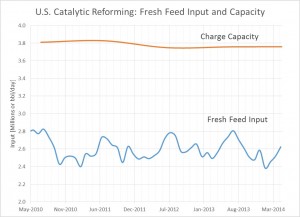The catalytic reforming process has been in existence since 1952 and had a purpose to convert low-quality naphtha, usually heavy crudes, into high octane reformate. Catalytic reforming may be one of the most popular and frequently used reforming processes but in reality there are many other processes including platforming, powerforming, ultraforming, magnaforming, reforming, and rheniforming. [1] The catalytic reforming process utilizes chemical reactions such as dehydrenation, dehydroisomerization, dehydrocyclization, and isomerication to convert the naphthenic type crude into an aromatic or branched isomer chemical compound. Once the continuous, cyclic, semiregenerative chemical process takes place, the products formed are light naphtha, hydrogen gas, and high octane reformate. Even though the main objective was to form the high octane reformate for high octane gasoline production, which grew into high demand since the introduction of high compression internal combustion engine, the byproduct of hydrogen gas has much more value. The pure hydrogen gas can be used in many other processes such as hydrotreating and hydrocracking. Another high priority of the hydrogen gas is to lower the formation of coke on the catalysts which extends the catalyst’s lifespan and lowers frequency of replacement. In order to lower coke formation, hydrogen will need to be recycled at high rates and pressures. [1]
Even though there are many benefits from catalytic reforming and it encompasses roughly 30 to 40% of the United States’ gasoline requirements, the process it is slowly being limited due to its formation of aromatic compounds. The EPA and California Air Resources Board (CARB) see these benzene aromatics as greenhouse gas pollutants and are restricting the blending of reformate into high octane gasoline. [1] The EPA and president Obama have created the Renewable Fuel Standard (RFS) regulations in order to achieve the reduction of greenhouse gas emissions, reduce the importation of petroleum fuels, and ultimately encourage the use of renewable fuels. The overall goal was to protect future generations from health issues and the threat of global warming. [2] Every time someone fills up at the pump, a form of this law can be observed from the sticker on the pump that illustrates the percentage of ethanol used in the gasoline blend.
Resources:
1. Gary, J. H., & Handwerk, G. E. (2007). Petroleum refining: technology and economics. New York: M. Dekker.
2. Regulations & Standards | Transportation and Climate. (n.d.). EPA. Retrieved July 13, 2014, from http://www.epa.gov/otaq/climate/regulations.htm

